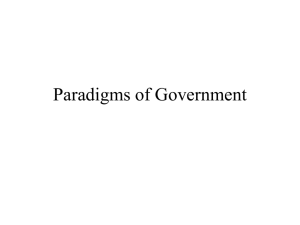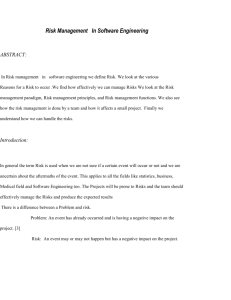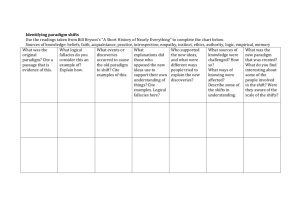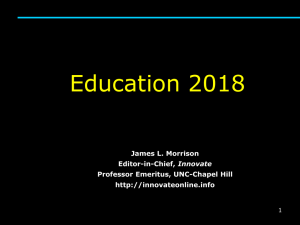Document 10466866
advertisement
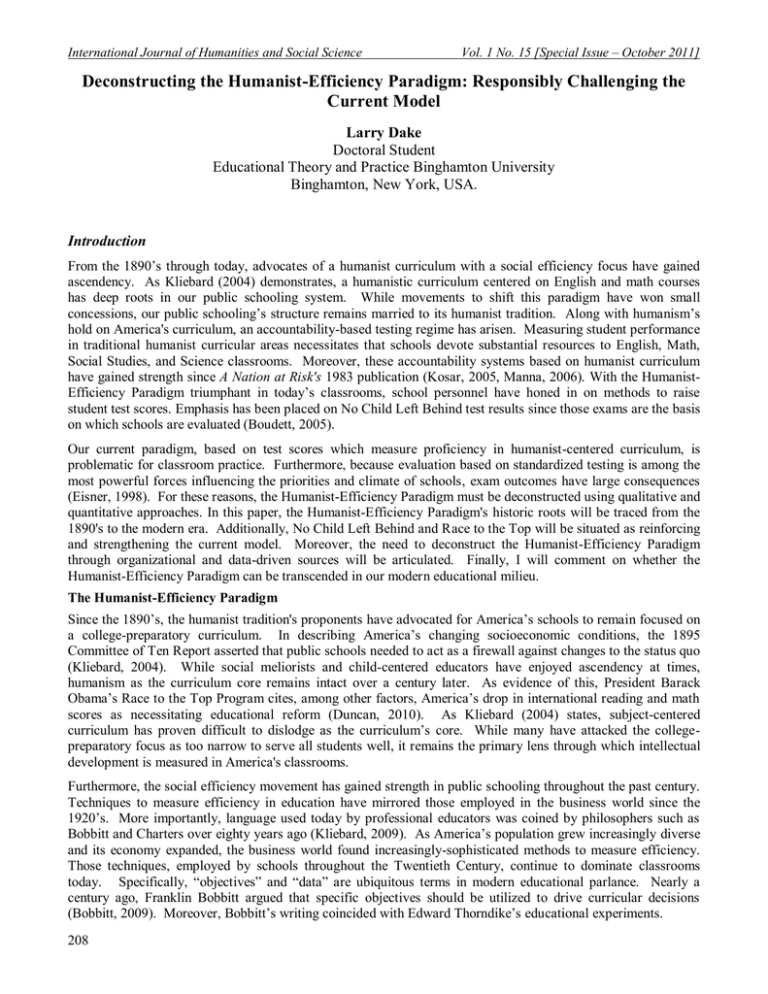
International Journal of Humanities and Social Science Vol. 1 No. 15 [Special Issue – October 2011] Deconstructing the Humanist-Efficiency Paradigm: Responsibly Challenging the Current Model Larry Dake Doctoral Student Educational Theory and Practice Binghamton University Binghamton, New York, USA. Introduction From the 1890’s through today, advocates of a humanist curriculum with a social efficiency focus have gained ascendency. As Kliebard (2004) demonstrates, a humanistic curriculum centered on English and math courses has deep roots in our public schooling system. While movements to shift this paradigm have won small concessions, our public schooling’s structure remains married to its humanist tradition. Along with humanism’s hold on America's curriculum, an accountability-based testing regime has arisen. Measuring student performance in traditional humanist curricular areas necessitates that schools devote substantial resources to English, Math, Social Studies, and Science classrooms. Moreover, these accountability systems based on humanist curriculum have gained strength since A Nation at Risk's 1983 publication (Kosar, 2005, Manna, 2006). With the HumanistEfficiency Paradigm triumphant in today’s classrooms, school personnel have honed in on methods to raise student test scores. Emphasis has been placed on No Child Left Behind test results since those exams are the basis on which schools are evaluated (Boudett, 2005). Our current paradigm, based on test scores which measure proficiency in humanist-centered curriculum, is problematic for classroom practice. Furthermore, because evaluation based on standardized testing is among the most powerful forces influencing the priorities and climate of schools, exam outcomes have large consequences (Eisner, 1998). For these reasons, the Humanist-Efficiency Paradigm must be deconstructed using qualitative and quantitative approaches. In this paper, the Humanist-Efficiency Paradigm's historic roots will be traced from the 1890's to the modern era. Additionally, No Child Left Behind and Race to the Top will be situated as reinforcing and strengthening the current model. Moreover, the need to deconstruct the Humanist-Efficiency Paradigm through organizational and data-driven sources will be articulated. Finally, I will comment on whether the Humanist-Efficiency Paradigm can be transcended in our modern educational milieu. The Humanist-Efficiency Paradigm Since the 1890’s, the humanist tradition's proponents have advocated for America’s schools to remain focused on a college-preparatory curriculum. In describing America’s changing socioeconomic conditions, the 1895 Committee of Ten Report asserted that public schools needed to act as a firewall against changes to the status quo (Kliebard, 2004). While social meliorists and child-centered educators have enjoyed ascendency at times, humanism as the curriculum core remains intact over a century later. As evidence of this, President Barack Obama’s Race to the Top Program cites, among other factors, America’s drop in international reading and math scores as necessitating educational reform (Duncan, 2010). As Kliebard (2004) states, subject-centered curriculum has proven difficult to dislodge as the curriculum’s core. While many have attacked the collegepreparatory focus as too narrow to serve all students well, it remains the primary lens through which intellectual development is measured in America's classrooms. Furthermore, the social efficiency movement has gained strength in public schooling throughout the past century. Techniques to measure efficiency in education have mirrored those employed in the business world since the 1920’s. More importantly, language used today by professional educators was coined by philosophers such as Bobbitt and Charters over eighty years ago (Kliebard, 2009). As America’s population grew increasingly diverse and its economy expanded, the business world found increasingly-sophisticated methods to measure efficiency. Those techniques, employed by schools throughout the Twentieth Century, continue to dominate classrooms today. Specifically, “objectives” and “data” are ubiquitous terms in modern educational parlance. Nearly a century ago, Franklin Bobbitt argued that specific objectives should be utilized to drive curricular decisions (Bobbitt, 2009). Moreover, Bobbitt’s writing coincided with Edward Thorndike’s educational experiments. 208 The Special Issue on Contemporary Research in Arts and Social Science © Centre for Promoting Ideas, USA Thorndike reinforced the need for specific curricular objectives by hypothesizing that functional learning did not transfer well to new situations (Kliebard, 2004). Students, therefore, needed specific, narrow instruction in certain areas to ensure successful learning. Specific objectives for English and Math were necessitated, for example, rather than broad goals encompassing both disciplines. Along with specific objectives, social efficiency advocates have long argued for schools to employ data analysis to inform curricular decisions. As Bobbitt articulated nearly a century ago, utilizing data in schools would identify deficiencies in student learning and in the curriculum as a whole. This data, in turn, would drive future educational objectives (Bobbitt, 2009). Assessing students’ progress in mastering curriculum, as well as measuring success based on that feedback, are standard practices in schools today. Along with our humanist-centric curricular focus, social efficiency through standardized testing remains lodged in today's dominant educational paradigm. Both the humanist-centered curriculum and social efficiency-driven testing regime are ensconced in schooling today. Despite postmodern attempts to deconstruct its meaning (Apple, 2004, Slattery, 2006), the HumanistEfficiency Paradigm remains dominant in classroom practice. While a narrowly-focused, college-preparatory curriculum whose successful implementation is determined by high-stakes assessments contains multiple shortcomings, the system has only gained strength in recent years. Goals 2000 and No Child Left Behind ushered in mandatory standardized assessments used to gauge student and school progress (Manna, 2006). Furthermore, the current Race to the Top program has narrowed student progress targets to English and Mathematics classes only. For the foreseeable future, the Humanist-Efficiency Paradigm will continue to dominate public education’s landscape. This paradigm’s natural outgrowth is an extensive and punitive accountability system. Small-scale testing during the 1990's exploded into mandatory annual testing in the 2000's. The 2010's have witnessed No Child Left Behind's extension as an educational "reform" movement. Students and schools will continue to be measured by their external assessment performance. Accepting the Humanist-Efficiency Paradigm the preferred means to measure student progress, policy makers have ushered in increasingly-targeted accountability measures over the past twenty years. The Growth of Accountability since A Nation at Risk Global economic competitiveness has been a paramount policy concern since the 1957 Sputnik launch and the 1958 National Defense Education Act (Kliebard, 2004). In that case, federal intervention into public schooling shaped national curricular decisions. At the Cold War’s height, this post-Sputnik legislation wrested curricular control from professional educators and placed it in government agencies. Couched in Cold War rhetoric, the National Defense Education Act reinforced fear that public schools were not advancing America’s national interest (Kliebard, 2004, Manna, 2006). Despite the Humanist-Efficiency Paradigm’s dominance, federal and state policymakers avoided direct student performance measurement throughout much of the Twentieth Century. A Nation at Risk, published in 1983, altered that policy approach. While the National Defense Education Act was viewed through a Cold War military-technology lens, A Nation at Risk primarily addressed America’s global economic competitiveness. Despite the Sputnik crisis, America’s technological superiority over the Soviet Union was evident. If any fear lingered that Soviet technology may outpace America’s innovative capacity, the 1969 Moon Landing eased national fears. A Nation at Risk, however, raised far deeper fears over America’s potential economic decline. During the Cold War, America’s potential destruction had a foreign face: the Communist Soviet Union. A Nation at Risk, however, addressed America’s own lack of global competitiveness resulting from its own educational decline. Directed inward at Americans and not outward towards a Communist enemy, A Nation at Risk ushered in drastic changes to America’s educational system. Direct attack from Soviet nuclear missiles was not America’s greatest threat, according to A Nation at Risk. Instead, the United States faced a “rising tide of mediocrity” in its schools (Bell, 1983). Like Franklin Bobbitt’s recommendation sixty years earlier, A Nation at Risk cites a plethora of educational data to support its findings. For instance, the report argued that American students were floundering on international achievement tests. Additionally, A Nation at Risk reported that SAT scores had plummeted over the last ten years (Bell, 1983). With the Japanese economy booming and Western Europe fully-recovered from World War II, America’s educational decline coincided with the need for increased technological competitiveness on a global scale (Bell, 1983). A Nation at Risk’s publication led the federal government to augment its role in public education. Primarily focused on equity during the 1960’s and 1970’s, the federal government shifted its spotlight to accountability during the 1980's. During the Reagan Administration, the National Assessment of Educational Progress (NAEP) exams were created. 209 International Journal of Humanities and Social Science Vol. 1 No. 15 [Special Issue – October 2011] Furthermore, Secretary of Education William Bennett’s SAT comparisons began conditioning policy makers to assess educational progress by test scores (Kosar, 2005). President Bill Clinton’s Goals 2000 agenda ushered in mandatory testing in traditional humanist areas such as English and Math. Although these exams were small in scale compared to the current testing regime, they laid the foundation for No Child Left Behind’s accountability system in 2001 (Kosar, 2005, McCluskey, 2007). Adding an additional layer to the Humanist-Efficiency Paradigm, President Obama’s Race to the Top program further reinforces the dominant approach in school curriculum design and implementation. Beginning with A Nation at Risk in 1983 and continuing through 2010, the steady march towards a wholesale accountability program has continued. Both Republican and Democratic Presidents have echoed the same concerns expressed in A Nation at Risk. Although the Humanist-Efficiency Paradigm has dominated school curriculum for the last fifty years, these mandated accountability systems represent a departure from past practice. While fears over America’s loss of global economic competitiveness have lingered, the need to measure student performance over a series to mandated assessments is a newer approach. Public education has been identified as America’s primary vehicle to avoid economic collapse (Manna, 2006). Additionally, student performance on standardized assessments has been singled out as the necessary tool to assess whether our school system is successful. Globalization themes that dominant throughout A Nation at Risk continue to drive educational decisions today. President Obama’s Race to the Top program, moreover, extends A Nation at Risk’s call to action and reinforces the Humanist-Efficiency Paradigm in several ways. No Child Left Behind, Race to the Top, and the Humanist-Efficiency Paradigm As aforementioned, the Humanist-Efficiency Paradigm has not only dominated curriculum development for nearly one hundred years, it has been chiseled in public policy since A Nation at Risk. In 2001, No Child Left Behind formalized this approach through mandated annual testing in grades three through eight. While accountability measures has evolved since the mid-1980’s, No Child Left Behind attached punitive measures to schools who failed to meet specific benchmarks (Klugh and Borman, 2006). While “Annual Yearly Progress” was incorporated into federal policy during the Clinton Administration, its use as a punitive measure for schools under No Child Left Behind was a stark departure from past practice. Furthermore, No Child Left Behind mandated annual testing in traditional subject-matter curriculum areas: English, Math, Science, and Social Studies. In this way, No Child Left Behind cemented the Humanist-Efficiency Paradigm in public policy. Because it represented the tested curriculum, traditional subject-matter was further reinforced as intellectual development’s yardstick. The Humanist-Efficiency Paradigm is strengthened further by President Barack Obama’s Race to the Top Program. Like No Child Left Behind, Race to the Top has been celebrated as an educational “reform” although it reinforces past public policy. Similar to both A Nation at Risk and No Child Left Behind, it cites America’s diminishing global economic competitiveness as the reform’s impetus (Duncan, 2010). While maintaining annual yearly assessments in traditional humanist curriculum areas, Race to the Top also establishes new paradigms for teacher and principal effectiveness. While No Child Left Behind held school systems accountable for student performance on external assessments, Race to the Top ties these scores to individual teachers and principals. No Child Left Behind established the Humanist-Efficiency paradigm as the measuring stick for school systems; Race to the Top brings that paradigm to the individual classroom and the principal’s office. Like No Child Left Behind, Race to the Top focuses exclusively on traditional subject-matter assessments. Concentrating on English and Math subjects only, Race to the Top represents a small departure from No Child Left Behind’s emphasis on English, Math, Science, and Social Studies. Additionally, Race to the Top disaggregates student performance data similar to No Child Left Behind: schools with thirty or more students in a subgroup for an assessed grade-level must meet specific benchmarks. Unlike No Child Left Behind, however, a value-added component exists (New York State Education Department, 2010). Under Race to the Top, not only must a total student population and subgroups make Annual Yearly Progress, their scores must increase by certain percentages from year to year. As aforementioned, this change focuses exclusively on English and Math performance in elementary, middle, and high school. Narrowing the curricular focus even further, Race to the Top seeks to measure annual and multi-year performance for students in traditional humanist subject areas. Reinforcing the Humanist-Efficiency Paradigm that has gained strength since A Nation at Risk, Race to the Top focuses on increasing student test score scrutiny. Additionally, President Obama’s program has been implemented as a “reform” initiative although it clearly augments measures already established under policies such as No Child Left Behind. 210 The Special Issue on Contemporary Research in Arts and Social Science © Centre for Promoting Ideas, USA Radically different, however, is the concept that individual teachers and principals will be accountable for student performance on standardized assessments. Administrators and teachers must be attuned to these changes. While powerful unions have participated in these changes, individual administrator and teacher voices have largely been excluded. Educator response to a strengthened Humanist-Efficiency Paradigm will be essential to both empowering students and meeting the annual benchmarks established by public policy. Simply lamenting these changes will not help students; rather, administrators and teachers must look to deconstruct this policy’s meaning and engage in student-centered collaboration. Because schools are hierarchically-structured with unequal power relationships, administrators must empower teachers to participate in and lead this deconstruction. Teachers, in particular, must be brought into discussions into how the Humanist-Efficiency Paradigm impacts classroom practice. Administrator and Teacher Response to the Humanist-Efficiency Paradigm Effective classroom teaching is largely recognized as the most important factor in student achievement. Therefore, teacher response to the augmented Humanist-Efficiency Paradigm determines how these changes impact students. Accountability-laden pressures, under an efficiency mantra and through No Child Left Behind and Race to the Top, are often inimical to established instructional practices. With curriculum’s focus narrowed and accountability’s presence enhanced, classroom practice and teacher autonomy have been impacted. Furthermore, a strengthened Humanist-Efficiency Paradigm creates downward pressure from policy makers to administrators to teachers (Klugh & Borman, 2006). When policies such as Race to the Top and its concomitant measures are established, it falls to administrators to implement these new programs. Then, administrators must filter these policies to the classroom and student levels. Despite implementation occurring within their classrooms, teachers lack a strong voice in the process. As formal implementers, teachers must be empowered to both critique the Humanist-Efficiency Paradigm and reshape it in a direction that empowers students to achieve. Without these opportunities, programs such as No Child Left Behind and Race to the Top merely intensify teacher workloads and do little to improve instructional practices (Apple, 2009). With more paperwork and less instructional planning time, both teachers and students suffer from the downward pressure associated with the Humanist-Efficiency Paradigm. Deconstructing the Humanist-Efficiency Paradigm and promoting teacher leadership are two ways that administrators can empower teachers to improve instructional practice and keep an eye towards standardized assessment results. Simply ignoring these exams’ importance is not healthy. While standardized assessments do not represent a complete student achievement picture, they do have ramifications for progress through the school system. Low scores on standardized assessments, for example, often mandate remedial courses. Students enrolled in remedial courses lose opportunities to engage in curriculum outside the traditional humanist construct. Deconstructing the Humanist-Efficiency Paradigm can help teachers recognize alternatives to our current assessment model and incorporate alternative methods into their curriculum. While deconstruction is a healthy exercise for professional educators, simply lamenting the system is not. Students are not well-served when teachers and administrators bemoan the current model without respecting its power to shape student movement through the modern school system. Ultimately, deconstructing the Humanist-Efficiency Paradigm involves both qualitative and quantitative approaches. Deconstructing the Humanist-Efficiency Paradigm through Qualitative Approaches Including teacher voices in deconstructing the current assessment model is crucial to understanding its implications. Too often, curricular changes flow downward from policy makers to administrators to teachers without an opportunity for dialogue among these levels (Herman, 2004). When this occurs, teachers often feel disempowered and disconnected from the decision-making process. Any successful deconstruction on the qualitative level must include opportunities for teacher leadership and shared decision-making among policymakers, administrators, and teachers. Deconstructing the current model must also be sensitive to how the Humanist-Efficiency Paradigm influences interactions among professional educators at the building and classroom levels. Hierarchically-structured, school systems do not naturally encourage dialogue among administrators and teachers. As a power relationship, administrators often implement the Humanist-Efficiency Paradigm by increasing their control over teachers’ work (Apple, 2009). Typically, this leads to increased paperwork: more progress reports, a greater emphasis on documenting all teacher, parent, and student interactions, and a brighter spotlight on potential litigation. According to Apple (2009), this intensification process redefines the educational community around labor needs rather than student needs. 211 International Journal of Humanities and Social Science Vol. 1 No. 15 [Special Issue – October 2011] Isolation grows, leisure time dwindles, and teacher self-direction suffers when the educational community becomes defined by labor needs rather than student needs. Deconstructing the Humanist-Efficiency Paradigm’s impact on these relationships entails recognizing the current model’s impact on classroom practice. In a model where standardized test scores lead to public praise or scrutiny, “curriculum” and “test preparation” are often equated. The Humanist-Efficiency Paradigm is so embedded in current practice that it is often considered normal. Apple (2004) points to curriculum’s potential for social control by embedding a seemingly “neutral” practice into everyday schooling. According to Apple (2004), the “supposedly neutral language of an institution…provides a framework that legitimates control of major aspects of an individual or group’s behavior (p. 136).” Preparing students for standardized assessments in English, Math, Science, and Social Studies is considered normal in schools today. Although the Humanist-Efficiency Paradigm dictates much of our current curricular and assessment focus, alternatives do exist. Engaging administrators and teachers in dialogue that recognizes the current paradigm’s non-neutrality and opens possible alternatives can further the deconstruction process. Moving beyond dialogue, however, is important to deconstructing the current paradigm. Because the overemphasis on standardized assessments promotes teacher isolation and work intensification, collaborative opportunities become lost. Administrators, therefore, have a responsibility to reestablish collaboration and student-centered decision-making as the educational community’s core. Empowering teacher leadership is an effective means to overcome this isolation (Teitel, 1996). Teacher leadership centered on collaboration must become as embedded in current practice as is the Humanist-Efficiency Paradigm. Too often, administrators downplay the level of teacher commitment needed to implement curricular and assessment changes associated with our current model (Vernez & Goldhaber, 2006). Empowering teacher voices and building teacher leadership are essential means to qualitatively deconstruct the Humanist-Efficiency Paradigm. School leaders must be attentive to how programs such as No Child Left Behind and Race to the Top promote teacher isolation and work intensification. Couched in the language of “reform,” these programs imply that current practice is failing America’s students. Opening dialogue among administrators and teachers around these issues, empowering teacher voices to express frustration, and fighting against work intensification are crucial deconstruction ingredients. Deconstructing the Humanist-Efficiency Paradigm through qualitative analysis by itself, however, fails to fully appreciate the vast implications these assessments have for students. This qualitative analysis based on dialogue and teacher empowerment, therefore, must be matched with a quantitative deconstruction that leads to enlightened interpretation of student performance in the Humanist-Efficiency Paradigm. Deconstructing the Humanist-Efficiency Paradigm through Quantitative Approaches Undoubtedly, the Humanist-Efficiency Paradigm represents what Michael Apple (2004) labels “hegemony.” Apple (2004) cogently argues that deconstructing our current schooling model requires that we ask “how and why particular aspects of the collective culture are presented in school as objective, factual knowledge (p. 12).” Within our current model, this “objective, factual knowledge” is oft-assessed and widely-reported. Because student test scores centered on hegemonic culture have tremendous implications for students, these data points must be deconstructed. Drilling down into student test scores can uncover previously-hidden constructs that impact student performance. Combined with qualitative sources, administrators and teachers can engage in rich conversations about the Humanist-Efficiency Paradigm and its impact on educational practice. The “achievement gap” among various ethnic and socioeconomic groups generally drives quantitative conversations about student test scores (Howard, 2010). Because standardized assessments represent “accepted” knowledge for student consumption (Apple, 2004), ethnic and socioeconomic differences mean that students raised outside the hegemonic norm face a tremendous disadvantage. For some, school curriculum seems second nature. Others, however, do not possess the social and cultural norms associated with success in American public schools (Apple, 2004 & Howard, 2010). Not surprisingly, these social and cultural differences manifest themselves in student test scores. Because these test scores have dire implications for student movement through the school system, the “achievement gap” must be quantitatively deconstructed. Dispelling myths about student achievement and test scores are necessary steps towards deconstructing the Humanist-Efficiency Paradigm. Datadriven decision-making is one of our current paradigm’s most powerful concomitants. Co-opting “scientific” language and concepts, educators armed with data can present their findings as objective and neutral (Apple, 2004). Contextualizing quantitative data such as student test scores is critical. 212 The Special Issue on Contemporary Research in Arts and Social Science © Centre for Promoting Ideas, USA Because students come to school from various socioeconomic contexts – and because curriculum is not “neutral” – it is necessary to discuss ways in which assumptions can lead to institutional discrimination (Johnson, 2002). No Child Left Behind test results, for example, carry an objective air because they represent a high-stakes summative assessment. Drilling down into data sets, however, uncovers how student subgroups approach curriculum differently. While test results do not measure everything, they do measure something. When specific student groups chronically underperform on standardized assessments, an opportunity exists to examine curriculum from various perspectives (Johnson, 2002). This examination represents an opportunity to deconstruct student test scores and their apparent objectivity. Along with their quantitative deconstruction, these student test results’ implications must also be questioned. As aforementioned, low test results often mandate remediation courses. By virtue of these remediation class periods, students with low test results are denied an opportunity to enrich their curricular experience through other course offerings. Quantitative efforts to link student performance on standardized tests to course offerings should be undertaken (Johnson, 2002). By deconstructing how test scores can lead to contracting educational opportunities, administrators and teachers can richly examine how the Humanist-Efficiency Paradigm impacts individual students and their futures. Examining existing conditions through student performance data takes on further importance as Race to the Top seeks to link test scores to teacher evaluations. Ultimately, qualitative and quantitative approaches should be combined when examining the current paradigm. Administrator and teacher dialogue focused on student performance results can lead to enhanced critical analysis. Most importantly, these data-driven conversations can empower educators to challenge our current system’s “taken-for-grantedness.” As Johnson (2002) notes, educators often fail to consider that “many of the practices and policies we take for granted have legacies (p. 73).” Student performances on standardized assessments, while biased and subjective, have drastic consequences for future quality of life. Therefore, administrators and teachers must deconstruct student test scores and promote dialogue around their implications for curriculum and instructional practice. Conclusion: Can the Current System be Changed? While humanism and social efficiency have long dominated American schools, their recent merger and the subsequent accountability system has only gained credence within the last twenty years. As Kliebard (2004) demonstrates, traditional subject-matter dominance over curriculum has survived several attacks from alternative philosophies. Its dominance will likely continue as the entire schooling edifice is built upon subjects as the curriculum’s core. In addition, social efficiency –inspired policies such as No Child Left Behind and Race to the Top are unlikely to fade away as along as American education is viewed as in crisis. Since 1983’s A Nation at Risk report, the consensus has been that America’s public schools are, in general, failing the nation’s children and compromising America’s economic competitiveness. Measurement-driven policies such as mandatory testing, “Annual Yearly Progress,” and value-added analysis will not subside as long as policy makers can use “education-in-crisis” as a political talking-point. As realities in our current model, administrators and teachers would be remiss not to accept the HumanistEfficiency Paradigm as victorious. Despite this status, No Child Left Behind, Race to the Top, and other elements of the current paradigm must be deconstructed. Qualitative deconstruction – by breaking down hierarchical decision-making, fighting work intensification, and promoting dialogue – should become common practices within school buildings. In addition, disaggregating student test scores for socioeconomic implications can lead to a critical systems analysis. Chronically underperforming students, for some reason, are not well-served by our current system. Utilizing data to challenge the current paradigm, rather than simply reinforce it, is the key. Student test scores are often misunderstood as “neutral” and “objective.” Deconstructing those assumptions can assist in challenging the Humanist-Efficiency Paradigm. These are long-term undertakings for school leaders. In reality, the current paradigm will gain further strength before it recedes. The Humanist-Efficiency Paradigm, however, possesses a fundamental flaw that will eventually be its downfall: it does not center “improvement” in the student her or himself. External assessments, teacher evaluation changes, and curricular revisions do not directly impact the dynamic, day-to-day lives of our students. The Humanist-Efficiency Paradigm tends to treat students as widgets to be produced rather than dynamic, social, and contextualized beings. As long as schooling remains about students, the HumanistEfficiency Paradigm will not usher in the “improvement” to public education that policy makers believe it will. 213 International Journal of Humanities and Social Science Vol. 1 No. 15 [Special Issue – October 2011] References Apple, M. (2004). Ideology and curriculum. New York, NY: RoutledgeFarmer. Apple, M. (2009). Controlling the work of teachers. In D. Flinders & S. Thornton (Eds.), The curriculum studies reader, 3rd ed. (pp. 199-213). New York, NY: Routledge. Bell, T.H. (1983, April). A Nation at Risk. Retrieved from: http://www2.ed.gov/pubs/NatAtRisk/title.html Bobbitt, F. (2009). Scientific method in curriculum-making. In D. Flinders & S. Thornton, (Eds.), The curriculum studies reader, 3rd ed. (pp. 15-21). New York, NY: Routledge. Boudett, K.P. (2005). Data wise: A step-by-step guide to using assessment results to improve teaching and learning. Cambridge, MA: Harvard Educational Publishing Group. Duncan, A. (2010, May 2). Educational status quo unacceptable. The Denver Post. Retrieved from: http://www.denverpost.com/headlines/ci_14987320. Eisner, E. (1998). The enlightened eye: Qualitative inquiry and the enhancement of educational practice. Upper Saddle River, NJ: Prentice Hall. Herman, J. (2004). The effects of testing on instruction. In S. Fuhrman & R. Elmore (Eds.), Redesigning accountability systems for education (pp. 141-166). New York, NY: Teacher's College Press. Howard, T. (2010). Why race and culture matter in schools: Closing the achievement gap in America’s classrooms. New York, NY: Teacher’s College Press. Johnson, R. (2002). Using data to close the achievement gap: How to measure equity in our schools. Thousand Oaks, CA: Corwin Press, Inc. Kliebard, H. (2004). The struggle for the American curriculum: 1893-1958, 3rd ed. New York, NY: RoutledgeFarmer. Kliebard, H. (2009). The rise of scientific curriculum making and its aftermath. In D. Flinders & S. Thornton (Eds.), The curriculum studies reader, 3rd ed. (pp. 52-61). New York, NY: Routledge. Klugh, E.L. & Borman, K.M. (2006). Comprehensive school reform vs. No Child Left Behind. In D. Aladjem & K. Borman (Eds.), Examining comprehensive school reform (pp. 143-177). Washington, D.C.: The Urban Institute Press. Kosar, K. (2005). Failing grades: The federal politics of education standards. Boulder, CO: Lynne Rienner Publishers. Manna, P. (2006). Schools in: Federalism and the national education agenda. Washington, D.C.: George Washington University Press. McCluskey, N.P. (2007). Feds in the classroom: How big government corrupts, cripples, and compromises American education. New York: Rowman & Littlefield Publishers. New York State Education Department (2010, November 9). Race to the top: Important Updates. Retrieved from: http://usny.nysed.gov/rttt/. Slattery, P. (2006). Curriculum development in the postmodern era, 2nd edition. New York, NY: Routledge. Teitel, L. (1996). Finding common ground: Teacher leaders and principals. In G. Moller &M. Katzenmeyer (Eds.), Every teacher as a leader: Realizing the potential of teacher leadership (pp. 139-154). San Francisco, CA: Jossey-Bass. Vernez, G. & Goldhaber, D. (2006). Implementing comprehensive school reform models. In D. Aladjem & K. Borman (Eds.), Examining comprehensive school reform (pp. 180- 218). Washington, D.C.: The Urban Institute Press. 214

